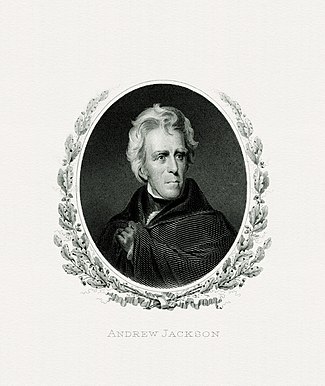BEP engraved portrait of Jackson as president.
| |
| Date | March 4, 1833 |
|---|---|
| Location | House Chamber, United States Capitol, Washington, D.C. |
| Participants | Andrew Jackson 7th president of the United States — Assuming office Martin Van Buren 8th vice president of the United States — Assuming office John Marshall Chief Justice of the United States — Administering oaths |
The second inauguration of Andrew Jackson as president of the United States took place in the House Chamber of the U.S. Capitol on Monday, March 4, 1833. The inauguration marked the commencement of the second four-year term of Andrew Jackson as president and the only four-year term of Martin Van Buren as vice president.
When arriving at the east front of the capitol for the inauguration, John Peter Van Ness, the Mayor of Washington, and members of the Council of Corporation greeted Andrew Jackson and Martin Van Buren and helped escort these men to the House of Representatives Chamber prior to the commencement of the swearing of oath.[1]
At 12:00, Chief Justice John Marshall swore in Andrew Jackson and Martin Van Buren into their respective offices in the House of Representatives Chamber, unlike the previous presidential inauguration that was held in the East Portico of the United States Capitol, as a result of the snowy grounds and the weather that reached about 29 °F.[2][3][4] In addition to that, Andrew Jackson's poor health status at the time of the inauguration essentially forced the swearing in of the oath of office to be held inside the House of Representatives Chamber.[5] People who attended the inauguration in the House of Representatives Chamber include the following: judges of the Supreme Court of the United States, the speaker of the House of Representatives, the president of the Senate, senators, foreign ministers, Andrew Jackson Donelson, and members of the House of Representatives, to name a few. Andrew Jackson walked up and took the seat of the speaker of the House and after pauses in cheers from the crowds, Andrew Jackson stood up and was sworn into office of the president of the United States, while having Mr. Donelson, who was Andrew Jackson's private secretary, on his right with Martin Van Buren on his left.[6] This inauguration marked the last and ninth time that Chief Justice John Marshall administered the oath of office of the president of the United States.[7]
Soon after taking the oath of office, President Andrew Jackson presented his inaugural speech to the multitudes of people in the Hall of the House of Representatives. Although Andrew Jackson made a speech, his vice president did not make a speech for the Inauguration.[8] In his Inaugural Speech, Andrew Jackson stated that he was humbled and honored by being re-elected president of the United States and stated that he would make a sincere attempt to improve the lives of the American people. In addition to these remarks, Jackson has please to state that the United States was currently not having any ongoing conflicts with nations around the world. Jackson also stressed out the importance of having a strong, unified union within all 24 states and having a cooperative state and federal government.
After Jackson's inaugural speech, there were two United States presidential inaugural balls. These inauguration made history in the sense that this was the first time in United States history when there was more than one inaugural ball. One the balls was held at Central Masonic Hall and the other was held at Carusi's.[9]
Although Andrew Jackson was a Democrat, Boston Republicans suggested that they were supporting the newly re-inaugurated president by having 50-gun salutes at 9:00 a.m. and at 12:00 p.m. under the direction of Captain Hoppin on the day of inauguration.[10]
- ^ "11 Mar 1833, 2 - The Vermont Patriot and State Gazette at Newspapers.com". Newspapers.com. Retrieved 2020-05-22.
- ^ "Inauguration at the U.S. Capitol". Architect of the Capitol. Retrieved 2020-05-22.
- ^ "Washington National Intelligencer Archives, Mar 6, 1833, p. 3". NewspaperArchive.com. 1833-03-06. Retrieved 2020-05-22.
- ^ "5 Mar 1833, Page 2 - The Evening Post at Newspapers.com". Newspapers.com. Retrieved 2020-05-22.
- ^ Bryan, Wilhelmus Bogart (1916). A History of the National Capital from Its Foundation Through the Period of the Adoption of the Organic Act. Macmillan.
- ^ "7 Mar 1833, Page 3 - The Maryland Gazette at Newspapers.com". Newspapers.com. Retrieved 2020-05-22.
- ^ "The Joint Congressional Committee on Inaugural Ceremonies". www.inaugural.senate.gov. Retrieved 2020-05-22.
- ^ "12 Mar 1833, Page 3 - Weekly Raleigh Register at Newspapers.com". Newspapers.com. Retrieved 2020-05-22.
- ^ "The Joint Congressional Committee on Inaugural Ceremonies". www.inaugural.senate.gov. Retrieved 2020-05-22.
- ^ "6 Mar 1833, Page 2 - Boston Post at Newspapers.com". Newspapers.com. Retrieved 2020-05-22.
